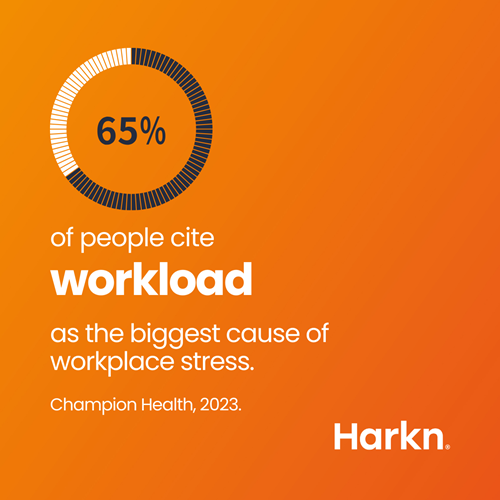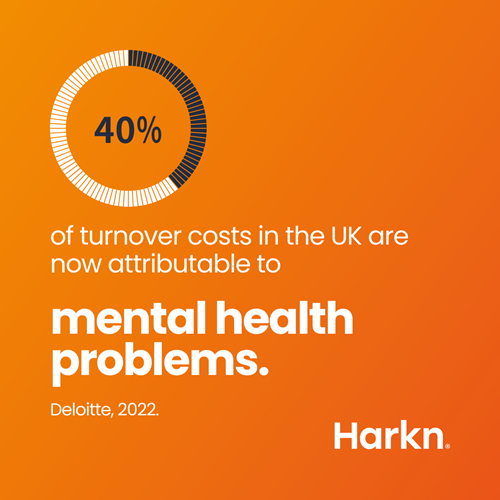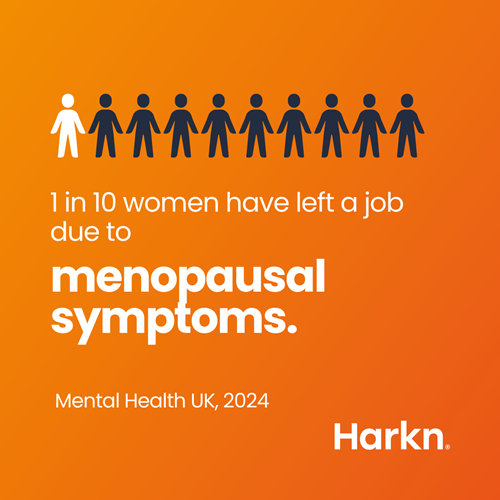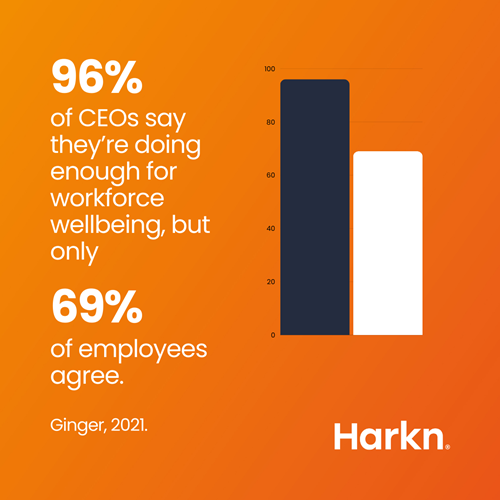The vast majority of organisations want to do right by their people, and dedicate significant time, money and personnel to employee wellbeing.
Yet prevalent wellbeing issues like burnout show no signs of abating, as they continue to impact both individuals and the bottom line in organisations.
So, how can organisations develop more robust wellbeing strategies that tackle these problems head-on?
We’ve pulled together some of the latest statistics and studies on the state of workplace wellbeing in 2024, and dive into what they can tell us about what’s needed for an effective approach.
Find out how Harkn can help your organisation level up its wellbeing strategy here.
The primary cause of poor workplace wellbeing is work itself

Research continues to highlight the primary drivers of poor wellbeing at work, and none of them are about the individual. Instead, things like work overload and lack of agency come up time and time again.
This calls into question why so many wellbeing strategies focus on individualistic wellbeing treatments, rather than foundational improvements to workplace culture. It’s well worth taking a look at University of Oxford’s recent study on this.
Infinite Potential’s 2024 State of Burnout Report identified three primary psychosocial hazards that play the biggest role in burnout:
- Job demand: Unmanageable workload and / or too few resources to manage the workload.
- Job control: Lack of agency over how, where and when work is done; insufficient involvement in work-related decisions.
- Workplace relationships: Conflict or unhealthy relationships with a supervisor, manager or co-workers.
Further research shows that:
- 54% of UK workers agree that a high or increased workload or volume of tasks at work caused them stress and may have contributed to burnout in the last year (1).
- 45% of UK workers agree that regularly working unpaid overtime caused them stress and may have contributed to burnout in the last year (2).
- 65% of people cite workload as the biggest cause of workplace stress (2).
- 37% of respondents to a recent CIPD survey identified management style as a key cause of workplace stress (3).
- High workload is the main cause of stress-related absence (3).
Poor employee wellbeing has a serious impact on business performance

The return on investment in improving employee wellbeing is increasingly clear, with evidence pointing to the impact wellbeing has on reducing absenteeism and presenteeism and boosting productivity.
It comes as no surprise that healthier employees do better work, but wellbeing is yet to be treated as integral to organisational success across the board.
Here are some of the most striking statistics to emerge recently:
- Burnt out employees have been 68% less productive than their healthy colleagues in the past 12 months (4).
- 1 in 5 UK workers needed to take time off work due to poor mental health caused by pressure or stress during the past year (1).
- Poor mental health cost UK employers £56bn between 2020 and 2021, compared to £45bn the year before (5).
- 40% of turnover costs in the UK are now attributable to mental health problems (5).
Women face a unique set of challenges when it comes to wellbeing at work

While there’s significant room for improvement in employee wellbeing across the board, evidence shows that women struggle with a unique set of physical and mental challenges during their working lives.
New statistics also show that women find it more difficult to speak up about their struggles and access support from their organisation.
- The rate of women experiencing burnout grew to 42% last year, while the rate of men experiencing burnout has decreased to 30% (4).
- Women feel less supported by their organisation when it comes to their wellbeing (48/100) compared to men (57/100) (4).
- 1 in 3 women struggle to speak out about their health at work (6).
- 1 in 10 women have left a job due to menopausal symptoms (1).
There's a perception gap between management and employees when it comes to workplace wellbeing

There’s a marked difference between how leadership tend to see wellbeing at work and how employees themselves experience it.
This is not down to mal intent, but rather gaps in the feedback loop when it comes to understanding how your people are doing and how well your wellbeing initiatives are landing.
- 96% of CEOs report that they are doing enough for workforce wellbeing, but only 69% of employees agree (7).
- 56% of employees think their company’s executives care about their wellbeing, while 91% of c-suite executives think their employees believe they care about it. (8).
- Only 25% of people professionals think managers in their organisations are confident and competent to spot the early signs of mental ill health (9).
- In CIPD’s most recent survey, people professionals identified ‘Lack of line manager skills and confidence’ as the top challenge for tackling employee health and wellbeing (10).
Peer support makes a positive difference to employee wellbeing

The impact of peer support is not as quantifiable as other elements of workplace wellbeing, but several studies have indicated the positive impact a culture of care and shared understanding has on overall employee wellbeing.
- A 2023 study concluded that employees who have positive social interactions with their managers and peers cultivate healthier professional relationships and, in turn, exhibit higher levels of wellbeing, motivation and performance (11).
- Employees who support others and feel supported by their peers can experience wellbeing benefits like positive emotions and improved career satisfaction, according to a 2020 study (12).
- A 6-month peer support intervention amongst junior doctors in 2020 resulted in improved wellbeing and enhanced confidence (13).
The key takeaways for leadership, HR and wellbeing professionals
From the silent struggle of employees suffering from a crippling workload to the difficulty women have in making their voices heard at work, many of these statistics and studies highlight a lack of effective employee listening.
Activating live and continuous employee listening is the only way to understand current sentiment inside your organisation and detect wellbeing issues as soon as they emerge.
It’s also essential for bridging the gap between the frontline and the boardroom inside your organisation, so everyone has a clearer picture of reality.
Tackle root causes head-on
There’s a concerning disconnect between the overwhelming evidence that work-related problems are the key driver or poor workplace wellbeing, and the sorts of wellbeing strategies organisations are following.
Measures like EAPs are vital to have in place, but they place responsibility on the employee to fix the problems they’re experiencing rather than addressing the context.
What’s more, over-reliance on resources like meditation apps and wellness and fitness classes fails to compensate for the very real causes of burnout, anxiety and depression that spring up in our everyday working lives.
A robust wellbeing strategy seeks to fully understand the different factors impacting employees and tackle them head-on.
This starts with live and continuous listening.
Guarantee psychological safety
It goes without saying that you can only help individuals in distress if you know about it, and more often than not people are reluctant to speak up when they’re struggling until it’s too late. They may have already disengaged from work, taken a leave of absence, or be working in a state of presenteeism.
This problem is especially acute for groups like women and neurodiverse employees, for whom the fear of stigma, misunderstanding and unconscious bias is more amplified.
A successful wellbeing strategy must ensure all employees have a safe avenue through which to voice their concerns without fear of the consequences, and for us at Harkn that means guaranteeing anonymity with every interaction.
It’s only then that you can ensure psychological safety, promote equal voice, and get to the heart of wellbeing issues in your workplace.
Invest in training and tooling
No matter how well thought through your wellbeing strategy is, it relies on successful implementation to succeed. That means leading by example and following through with meaningful action.
As CIPD’s recent report showed, one of the main hindrances to delivering on employee wellbeing remains a lack of confidence and skills in line managers.
Training your line managers and Mental Health First Aiders in noticing the signs of poor wellbeing in individuals and how best to reach out and offer them support is a vital starting point, but the correct tooling is just important.
Many are not confident enough to speak to their manager or an HR or wellbeing professional without the protection of anonymity, and waiting for the next employee survey is simply too slow.
Activate live, anonymous dialogue to give your leaders the clarity and confidence they need to intervene in a way that preserves dignity and champions equal voice.
Enable peer-to-peer support
Employee wellbeing is not just about top-down support, but creating a culture of care and embedding wellbeing in day-to-day work life.
The recent scandal at The Post Office cast into sharp relief what happens when people don’t hear about the lived experiences of their peers.
Peer support helps to combat loneliness and create a sense of belonging, easing the struggles that many employees face in their working life – particularly where remote working is involved.
Activate anonymous and transparent channels for dialogue about a range of topics to improve shared understanding and empathy and strengthen workplace relationships.
Further reading and resources
Developing a robust approach to employee wellbeing is no easy feat, but we’re here to help.
We recently published a new eBook all about this topic, which equips leaders and people managers with the tools they need to transition to a more proactive, data-driven approach to workplace wellbeing.
You can download your free copy here.
In the meantime, find out more about how Harkn can help you to improve wellbeing in your organisation here, or book a virtual coffee with us at a time that suits you.
References
1: Mental Health UK: The Burnout Report: 2024
2: Champion Health: The Workplace Health Report: 2023
3: CIPD: Health & Wellbeing at Work: 2022
4: Infinite Potential: State of Burnout Report: 2024
5: Deloitte: Mental Health and Employers: 2022
6: Department of Health & Social Care: Women’s Health – Let’s Talk About It: 2022
7: Ginger: Workplace Attitudes Towards Mental Health: 2021
8: : Deloitte: The C-Suite and Workplace Wellness: 2022
9: CIPD: Health & Wellbeing at Work: 2020
10: CIPD: Health & Wellbeing at Work: 2023
11: Alan et al: Improving Workplace Climate in Large Corporations: 2023
12: Giacumo et al: Evidence on the Use of Mentoring Programs and Practices to Support Workplace Learning: 2020
13: Elamin and Cussons: ‘Improving Wellbeing Through Peer to Peer Support’: 2020





